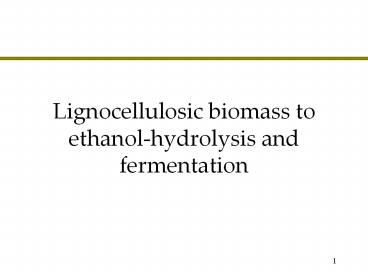Lignocellulosic%20biomass%20to%20ethanol-hydrolysis%20and%20fermentation - PowerPoint PPT Presentation
Title:
Lignocellulosic%20biomass%20to%20ethanol-hydrolysis%20and%20fermentation
Description:
... Bioconversion of biomass to ethanol (hydrolysis) Trichoderma reesei Trichoderma reesei is an industrially important cellulolytic filamentous fungus. – PowerPoint PPT presentation
Number of Views:1583
Avg rating:3.0/5.0
Title: Lignocellulosic%20biomass%20to%20ethanol-hydrolysis%20and%20fermentation
1
Lignocellulosic biomass to ethanol-hydrolysis and
fermentation
2
Agenda
- Enzymatic hydrolysis
- Cellulases
- What is fermentation?
- Fermentation inhibitors
- Separate Hydrolysis and Fermentation (SHF) and
Simultaneous Saccharification and Fermentation
(SSF)
3
Bioconversion of biomass to ethanol (hydrolysis)
Liquid phase
Sugars
Ethanol
Pretreatment
Fermentation
Biomass
Lignin
Recovery
Solid phase
Cellulose
Hydrolysis
Fermentation
Ethanol
Sugars
4
Enzyme Function
- There are a large number of fungal enzymes
responsible for the breakdown of each wood
component. Each enzyme plays specific roles - Endo-beta-1,4-glucanase acts within the chain,
breaking it into smaller units and providing more
"ends" for CBH. - Cellobiohydrolase (CBH), acts on the end of the
molecule successively cleaving off the
disaccharide cellobiose. - Beta-glucosidase (or cellobiase) which cleaves
cellobiose to two glucose units.
5
Trichoderma reesei
- Trichoderma reesei is an industrially important
cellulolytic filamentous fungus. - T. reesei
- present in nearly all soils and other diverse
habitats - favored by the presence of high levels of plant
roots.
Trichoderma reesei
6
Cellulases
Binding domain
Catalytic domain
Endoglucanases (EG) cutting the cellulose
chains randomly
Cellobiohydrolyses (CBH) cutting cellobiose
units of the ends of the cellulose chains
7
Rapid microassay method (1)
Pretreated substrate
Flasks
Pretreated substrate
Handsheet
Microplate
8
Rapid microassay method (2)
Microplate
Handsheets
HPLC
Shaker
Microplate Reader
9
Equipment
1mL
200 mL
4L
40L
10
Bioconversion of biomass to ethanol (pretreatment)
Liquid phase
Sugars
Ethanol
Pretreatment
Fermentation
Biomass
Lignin
Recovery
Solid phase
Cellulose
Hydrolysis
Fermentation
Ethanol
Sugars
11
Fermentation
- Defined as
- Cellular metabolism under anaerobic conditions
(absence of oxygen) for the production of energy
and metabolic intermediates - Many organisms can ferment (i.e., grow
anaerobically) - Not all produce ethanol as an end-product of
fermentation - Butanol
- Acetic acid
- Propionic acid
- Lactic acid
12
Strain selection
- Choice of microorganism for ethanol production
has traditionally been a Yeast - Yeast
- Single cell microorganism
- Fungi
- Facultative anaerobe
- Most common industrial fermenter is Saccharomyces
cerevisiae (bakers or brewers yeast) - Why?
13
Why S. cerevisiae?
- Has been selected over thousands of years
- High ethanol yield and productivity
- Relatively simple to culture
- G.R.A.S organism
- Robust
- High ethanol tolerance
- Resistant to inhibitors
14
Fermentation (1)
15
Fermentation (2)
Conversion factor 0.51
1g/L of glucose 0.51g/L ethanol (maximum)
16
Inhibitors
- 5 groups of inhibitors
- Released during pretreatment and hydrolysis
- Acetic acid and extractives
- By-products of pretreatment and hydrolysis
- HMFs and furfurals, formic acid
- Lignin degradation products
- Aromatic compounds
- Fermentation products
- Ethanol, acetic acid, glycerol, lactic acid
- Metals released from equipment
17
HMFs and Furfurals
18
Experimental
Steam Explosion (solid liquid fraction)
Corn fibre
Hydrolysis
Fermentation
SHF
50C, pH 4.8 48 hours
30C, pH 6 12 hours
Steam Explosion (solid liquid fraction)
Corn fibre
SSF
37C, pH 5 24 hours
19
Pros and cons of SHF and SSF
SHF
SSF
- Pros
- Separate temp. for each step (hydrolysis 50C,
fermentation 30C) - Possibility of yeast and enzyme recovery
- Cons
- Requires two sets of fermenters
- End-product inhibition
- Pros
- Minimized end-product inhibition
- Requires only one set of fermenters
- Cons
- Difficulties in recovery and yeast and enzyme
recycling - Temperature/pH compromise (37C)































